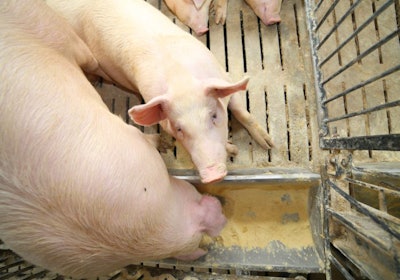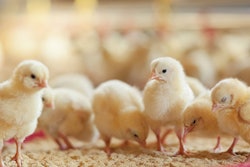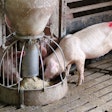
Erin Bryan, swine nutritionist at Land O’Lakes Purina, discusses pig immunity and how nutrition and animal husbandry can help boost a pig’s immune system during challenging periods in its life.
How nutrition, animal husbandry can boost pig immunity (24:37)
Ann Reus: Hello and welcome to the Feed Strategy podcast. I’m your host, Feed Strategy senior reporter Ann Reus.
Erin Bryan is a swine nutritionist at Land O’Lakes Purina. We recently spoke about pig immunity and how nutrition and animal husbandry can help boost a pig’s immune system during challenging periods in its life. We also discussed new insights and research in the areas of pig health and nutrition.
Here’s our conversation.
Hi, Erin, thanks for being here.
Erin Bryan: Oh, thank you so much for having me. I’m really excited.
Reus: So, you do a lot of work with the immune system in pigs. Can you describe some of the major challenges to a pig’s immune system?
Bryan: Absolutely. It kind of depends on the stage of production, which is where it gets interesting, right. And so if we’re thinking about pigs that are recently weaned, one of the major challenges that they have is that their immune system actually doesn’t mature until about eight weeks of age. And so if you think about the typical weaning age of a pig, that’s about three weeks of age. And so up until that point, they have lactogenic immunity, meaning that they’ve got maternal antibodies from milk, right? But unfortunately, that wanes at about five to seven days post weaning, and so we’re talking about four weeks’ time period between where they had this lactogenic immunity, and where that immune system is fully mature, or at least fully developed. I don’t know if I want to call it mature, necessarily. And at that same time, pigs are undergoing a lot of different stresses: dietary changes, social stress, novel pathogens from a new environment, things like that. And dietary changes, a lot of people don’t necessarily think about the gut as being a major immune organ, but it makes up about 70%, of a pig’s immune system in this early part of life. And so when we stress that gut, we’re actually stressing a big portion of their immune system as well. And so even something is as simple as going from milk to a solid diet, we’re starting to stress that that animal out, it’s starting to tax that immature immune system.
Social stress, too, you know, I always joke, to me, that weaned pigs are kind of like a kid entering high school for the first time. They have, they have a couple of things that they need to worry about, including making new friends. And so that results in a lot of cortisol. And so if you think about cortisol, that’s kind of the stress hormones, which you think about with your fight-or-flight response. And cortisol is actually antagonistic to the immune system. And so if you think about it, you’re trying to run away from something, right, and you’ve got a lot of cortisol pumping through your system, you don’t want that energy to go towards your immune system in that very moment. You want it to go towards whatever you need to do to run away, right. And so that social stress, and that uptick in cortisol actually is immunosuppressive. And so if that pig comes into contact with novel pathogens in that new environment, or from pigs from other litters, things like that, it actually is more difficult for them to overcome that pathogen.
And then at the same time, if you jump forward kind of in production, in the breeding herd, pregnancy itself is kind of inherently an immunocompromised state. And so you think about the immune system being the gatekeeper, so to speak, of what is self is versus what is not self, the immune system actually needs to be suppressed in order to not recognize the litter as quote, unquote, not self. And so there is a whole complicated regulatory system in place that happens when a sow becomes pregnant, that prevents that immune system from attacking the litter as being something that is outside of herself. Not to mention the fact that there are huge energy requirements for litter growth. And so those energy requirements will take away from that immune system. So if she were to come into contact with something, she’s now fighting herself, essentially, that sow is, between whether she wants to put that energy towards growth or towards that immune system.
And my favorite part, given my background a little bit, there’s actually a primordial immune system, primordial meaning primitive, so to speak, that begins to develop in these fetuses in the third trimester. And there’s research out there that indicates that this primitive immune system can actually respond to external stimuli. And so if mom is sick, for example, some of those signals that she produces in order to recruit more of her immune system to a particular place, or at least tell it that that there’s a pathogen present and that, you know, we need to ramp up a response. Some of those signals are actually communicated across the placental barrier and can initiate a basic response in that developing immune system in the fetus. Not to mention that some pathogens can cross the placental barrier, you know, PRRS (porcine reproductive and respiratory syndrome) comes to mind is kind of the quintessential example of that. And those pathogens can result in sort of a primitive immune response in that fetus. And what’s really interesting to me about this is there’s been research out there that’s indicated that if this happens during gestation, that that fetus, when it becomes a pig will actually have differential immune responses compared to pigs that were not exposed to this sort of stimuli in gestation. And so, you know, we think about challenges to a pig’s immune system, I mentioned two that are pretty stereotypical, if you will, that that post-weaning state, and then in the breeding herd, you know, gestating sows, but I think that there’s a third one here, that kind of goes with those gestating sows that we need to think about the effect that that has on the piglets as well
Reus: That’s a lot of potential challenges. What do those health challenges do to the performance of the animal at different life stages?
Bryan: So it’s almost always detrimental, right. And, and I feel like a lot of producers are very familiar with this, unfortunately. When you walk through the barn, usually, the first indication that you have something going on is a dip in productivity, right. And so when you think about those weaned pigs, this immature immune system is not very efficient, but it also requires a ton of energy. And so you think about energy being taken in via the feed, right, and then that energy, we want it to go towards muscle growth, you know, towards lean growth. But instead, if this pig comes into contact with a pathogen at this time, the immature immune system will actually leech that energy away from lean growth or steal it away. And so what you’ll see when you walk the barn is those slow-growing, not-efficient pigs. And depending on the pathogen, this might persist for quite some time, you know, again, PRRS being kind of the quintessential example of sticking around for an extended period in your nursery. PRRS requires a pretty robust immune response and so that immune system is constantly stealing that that energy that that pig is taking in and so it can’t go towards lean growth.
On top of that, some of these pathogens, depending on the severity, are actually so robust that the immune system will start to pull energy from other places like the muscle. And so what it’ll do is actually start to catabolize that muscle and break down that protein such that they can use it for energy. And that’s where you get some of these wasting pigs that you see in some of the more severe strains of PRRS or mycoplasma, or things like that, flu. Not to mention, on top of that, sick pigs don’t eat. And so this is almost always confounded by reduced energy intake. So not only do we need more energy for our immune system, which is taking away from that energy available for lean growth, but we’re actually not even eating as much. And so we’re not actually taking in as much energy as we need at that point.
For the sow, in this case, this means that less energy can go towards the litter. And so that’s what results in smaller pigs when you think about, you know, a sick sow that is gestating at that point. And on top of it, excessive inflammation is detrimental to pregnancy, because it can cause cell death. And so you think about inflammation being a signaling pathway for the immune system, right, it’s kind of like the lights and sirens on the police car. Unfortunately, if inflammation occurs in excessive amounts, or for a prolonged period of time, and it’s not communicating with just the immune system, it gets exposed to other types of tissues like lungs, or the placenta or the uterus, it will actually induce cell death in those tissues. And so, I keep using PRRS as an example, but you think about those mummies in PRRS or the stillbirths in PRRS, a lot of times that’s due to the apoptosis in the placenta, or the uterus, either from a lack of energy because that sow is not eating as much as she needs to to maintain an immune response and a pregnancy, or from the excessive inflammation, actually causing apoptosis in that placenta or uterus.
And then on top of – kind of along those same lines – but on top of that at the same time, this inflammation can also cause apoptosis in the lungs. And so you think about respiratory illnesses, usually having pneumonia involved, right. And so pneumonia lesions are actually pockets of the cell deaths that you can see. And so if that pig doesn’t pass away, or die, from that cell death, initially, it will start to heal and scar in that lung tissue. But unfortunately, this results in reduced aerobic capacity later in life and so a pig might survive, say, a flu infection early in life and have some of the scarring from pneumonia on its lungs, but then if it comes into contact with another respiratory pathogen like PRRS later on in the finishing period, it now has such a reduced aerobic capacity that it actually can’t overcome it. And that’s where you’ll see these pigs succumb to something else later on in life. And so health challenges as a whole, I mean, they’re never awesome, and they’re confounded by a lot of different things that we necessarily don’t have control over.
Reus: What kinds of feed additives can help pigs through difficult periods, and how do they work?
Bryan: So that’s been the million-dollar question, right? I think there have been a lot of different scientists, a lot of different companies that are chasing after this answer. And what’s so interesting to me about the immune system is what makes it so frustrating to work with. It is absolutely wonderfully complex. And it’s unique to each pig. And so we’ve done a fantastic job in the industry of making pigs very homogenous, so to speak, such that we’ve got a very consistent pig, depending upon, obviously, you know, within genetics and things like that. But we haven’t necessarily achieved that when it comes to that pig’s immune response. And so, while that makes it incredibly interesting to study, it also makes it incredibly hard to come up with something that’s going to be useful for every single pig, right. And that’s why historically, interventions have focused on a particular pathogen rather than immune support. We can characterize a particular pathogen, we know that, you know, a particular strain of a virus is going to more or less look the same across different herds that it infects. Obviously, there’s string differences, but there’s usually some epitopes that are kept consistent across those strains that we can target.
But as we switch focus to nutraceuticals, if you will, there’s a couple of things that are showing promise in helping the immune system itself rather than necessarily attacking a pathogen. So, for example, direct fed microbes have been coming into the limelight recently. And we’ve discovered that they’re incredibly useful for outcompeting bad bacteria in the gut, for example. Not only that, but they can produce byproducts that are helpful to the immune system, that provide energy to the immune system that help activate some of those initial responses that are required early on to help overcome an infection. And those byproducts can also be helpful to beneficial bacteria.
And so you think about the gut microbiome being a huge hodgepodge of all sorts of different types of bacteria, what we’re talking about here is introducing something that’s going to essentially starve out those bad bacteria or those pathogenic bacteria, while at the same time feed the beneficial bacteria, the bacteria that we want to persist in that gut. One of our products takes advantage of this and it also has a fiber component that captures those pathogenic bugs and contains them to prevent re-exposure, which has been super helpful thinking about some of these enteric issues. A lot of times, unfortunately, one of the reasons why they persist so much is that these pigs are constantly re-exposed to them as they get excreted, right? Pigs are messy, they like to root around and all sorts of different things. And fecal-oral is a very common route of transmission for a lot of these, and so having that that fiber component that really contains those pathogenic bacteria after being excreted has been really helpful there.
Medium-chain fatty acids have also shown some promise. They are known to bind to a particular receptor on immune cells that helps prime them for a pro-inflammatory response in the presence of a pathogen. And so what’s really nice about medium-chain fatty acids is that they have to be in the presence of a pathogen in order to elicit this pro-inflammatory response. And so it’s not like feeding them is going to cause a pig to be inflammatory for no reason, if you will, you know, there has to be a pathogen present in order for this pro-inflammatory response to occur. And you think about some of the illnesses that pigs are exposed to, having that pro-inflammatory response is a very good thing. You know, and that might seem contradictory to kind of what I was talking about earlier, saying that we’re stealing energy away from lean growth. And while we would be in this particular situation, you know, stealing energy away such that we can mount this pro-inflammatory response, having one good, effective pro-inflammatory response is actually needed for the success of that pig, such that we can eradicate that pathogen and move on, if you will, so it doesn’t just hang around. And so medium-chain fatty acids have shown promise here and helping really make that pro-inflammatory response, that initial immune response, really robust.
They also have an antibacterial effect on a variety of different species. But kind of combing through the literature and what we know about it so far, the overall take-home is that they need to be supplemented early on. And so they’re not going to replace pharmaceuticals in that way. You think about any antibacterial pharmaceutical that you can start after you have a robust infection, medium-chain fatty acids aren’t going to have that same effect. But if they’re in the diet pre-emptively, or earlier on in infection, they absolutely can help with that antibacterial effect. Partially due to this, they’re known to manipulate the gut microbiota. And that has resulted in improved intestinal integrity and reduced intestinal inflammation. But the mechanism behind these changes, not super well understood. And so I think that’s where a lot of the industry is heading right now is kind of trying to understand exactly what the mechanisms are behind these effects such that we can manipulate them even further to really work for us.
Reus: You know, almost every conversation I’ve had with anyone recently in the animal health and nutrition industry, someone has mentioned, the microbiome and gut health. Do you think that’s the real key to improving and focusing on animal health overall?
Bryan: I think it’s certainly a door we need to walk through, right? What’s really exciting about being kind of new to the industry right now is we are kind of on the landing pad at the moment, when it comes to the gut microbiome, particularly when we’re talking about the gut microbiome at the intersection of animal health and nutrition, right? We know that we can impact the microbiome by what we feed. And we know that the microbiome impacts health. What we don’t know is kind of all of the steps in between, right, to get from point A to point B. And so it’s a really exciting time to be a scientist, in my mind, because, you know, figuring these things out, that’s what we love, right. And so I think that it’s something that has a lot of potential, I think it’s something that needs to be understood a little bit better.
Reus: What else can producers do to support pigs when they’re faced with a health challenge?
Bryan: I think it’s important to work with your health service team and nutritionists, when you’re faced with a health challenge. You know, unfortunately, there’s no blanket statement that I can say here that’s going to fix every single infection, because those recommendations are going to change depending upon the particular pathogen. There’s a couple overall goals, though, that are going to stay the same, including you need to support feed intake, right. So I’ve talked a couple of times now about how the immune system really requires a lot of energy when it’s fighting off a pathogen, particularly in those newly weaned pigs. And so anything that you can do to help support that feed intake would be helpful, right. And that might come in the form of a particular palatant, or a pelleted diet to help encourage that feed intake. We know that, you know, anorexia is a sickness behavior, it’s not something that the pigs can control. When they don’t feel well — it’s just like humans – when you don’t feel well, you don’t want to eat a lot. And we know that that’s important for the pigs for survival, right. But we also know that getting energy into that animal is absolutely integral when it comes to helping them overcome a particular pathogen.
We also know that we need to help support the immune system and help it fight back. And so that’s where some of these nutraceuticals that I’m talking about can come into play. And your health service team or your nutritionists are going to be on the cutting edge of understanding what’s available to you, and what might work for your particular issue. The next couple of things, you know, they sound great when I say them, you know, but it’s hard to implement in practice. And that’s controlling the spread and mitigating severity, right. And so controlling spread, that comes down to good biosecurity. And so I think what producers are, are really well versed in biosecurity, and that’s a strength in our particular industry. Mitigating severity could come in a couple of different forms, pharmaceuticals might be indicated, that’s where you need to work with your health service team and figure out if you need pharmaceuticals, what dose, for how long, which ones, things like that. Electrolytes might help improve nutrient uptake, particularly if you’re dealing with a diarrhea of some sort. It’s really important to make sure that those animals are getting as much nutrition as they possibly can. And when you have something like an enteric issue that’s resulting in diarrhea, you know that those animals are having reduced absorption of those nutrients. And so, even though, you know, it’s kind of double whammy, even though they’re not eating as much, what they are eating is not even getting absorbed that well. And so those are two sort of hills that that animal has to climb to even get something into its body.
Overall, though, I think the most important thing is to keep a really good eye on your herd and raise the alarm early if you think you have a problem. The earlier that you can get involved, the earlier you can start implementing some of these interventions, the better off you’re going to be. I also think it’s really important to ask a lot of questions from your health service team and your nutritionists. Ask a lot of questions of all the people that are in your orbit that you think might be useful for this. I guarantee that they’re willing to talk about it. And they’re willing to work with you to figure out what it is that they can do to help you overcome this issue.
Reus: Yeah, that’s a lot of really good advice. Well, being that you are a scientist, do you want to tell me about some of the research you’ve been working on lately?
Bryan: Absolutely. I came on at a really exciting time in Purina. We just launched two new feed additives. And I mentioned medium-chain fatty acids earlier on in this episode, and that’s exactly what we’re looking at here. And so we’ve looked at these products in a viral context. So we’re talking about a viral challenge. And it looks extremely encouraging. Again, you know, this is one of the things that we need to understand exact pathways. But as far as improving performance, and supporting that immune system, when it comes to reducing viral load, things like that, we’re seeing some really encouraging results here.
What’s also interesting to me, is we’ve done some work with the nasal microbiome in this particular product, which is really exciting, because there’s not a lot of nasal microbiome work out there. But you think about respiratory illnesses, and pathogenesis of respiratory illnesses, we know that there’s microbes in the respiratory tract, right. And we know that just like the gut microbiome, pathogenic bacteria can overtake the nasal microbiome. And so that’s where you might get some of these co-infections, or the sort of never-ending respiratory issue, right, that a lot of producers deal with. And so this particular product, it’s got a lot of different components in it, but again, that those medium-chain fatty acids have been really helpful. Really, really encouraging, here. Again, going back to those mechanisms earlier, we were talking about binding to a particular receptor on the immune system to help with that pro-inflammatory response such that we can hit that pathogen hard and only hit it once rather than having this this never-ending issue.
We also have a project going on here focusing on developing individual cocktails of direct-fed microbials for a particular farm. And so going back to that concept of introducing good bacteria in order to outcompete bad bacteria, what we’re talking about now, we understand that different farms, different management strategies, different genetics, different ages, all of those things play a role in the development of a gut microbiome. And so we’re not expecting to see the same type of microbiome from farm to farm, or even within a farm from unit to unit, right. And so what we’re what we’re trying out here, what we’re working on here at Purina is the concept of, if you have a farm that’s endemic with something going in, taking samples, understanding what the problem is exactly, getting a really good characterization of what’s happening in your pigs’ gut microbiome, and then developing something that’s unique to that particular flow of pigs, that we can come back, put in your feed and hopefully, take care of that particular pathogen that you’ve got going on. And so, like I said, really exciting time to come in, because not only we’re kind of attacking this intersection of nutrition and health from both fronts, both from that supporting the immune system component, and then from that microbiome component as well.
Reus: Well, thank you so much, Erin. This is really fascinating.
Bryan: Oh, thank you so much for having me. I love talking about this stuff.
Reus: I can tell.
And I hope you enjoyed this episode of the Feed Strategy podcast. Thanks for listening. I’m Ann Reus.
















